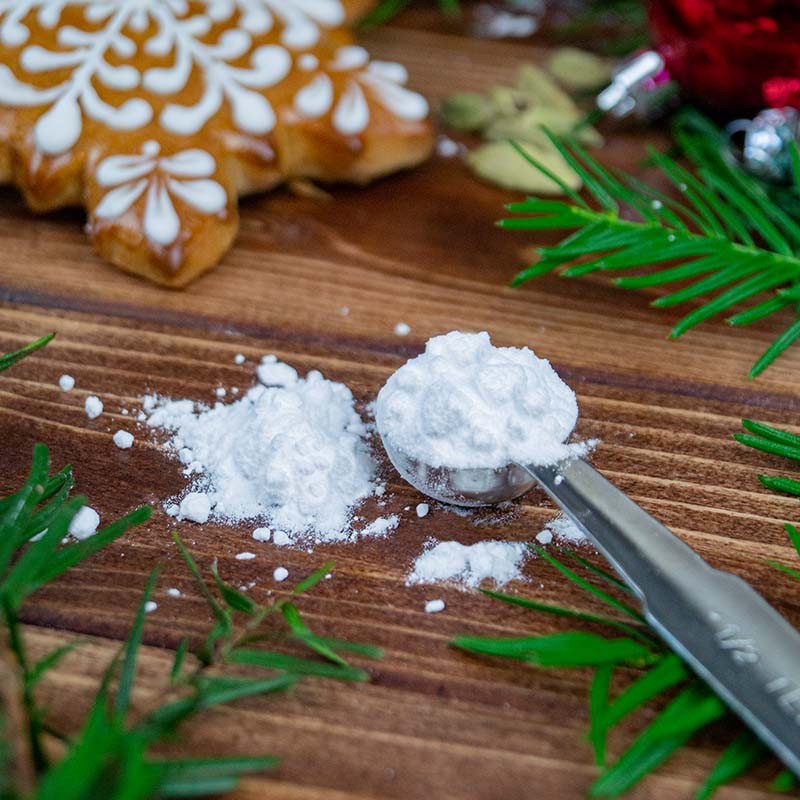




Salt for leavening is a leavening agent for various flat pastries such as Biberli, stomach bread or gingerbread. In particular, raising salt is preferably used for sugar-containing doughs such as honey cake. Deer horn salt is also known as raising salt. The raising agent, similar to yeast or sourdough, ensures that even heavy doughs rise nicely. Leavening salt differs from sourdough and yeast in several respects. Unlike the other leavening agents, the dough will rise in width rather than height. In this container are 50 g of leavening salt and is enough for 5 kilos of flour
Data sheet
Salt for raising is a raising agent for various flat pastries such as Biberli, stomach bread or gingerbread. In particular, raising salt is preferably used for sugar-containing doughs such as honey cake. Deer horn salt is also known as raising salt. The raising agent, similar to yeast or sourdough, ensures that even heavy doughs rise nicely. Leavening salt differs from sourdough and yeast in several respects. Unlike the other leavening agents, the dough will rise in width rather than in height. In fact, gingerbread is known precisely for keeping the cake flat, but still making it nice and airy. Just as with cornstarch, salt must be dissolved in water, milk, egg white or cream. This ensures better distribution in the dough.
An airy, light and delicious gingerbread dough succeeds perfectly with raising salt. The raising agent forms three different gases during baking. The gases ensure wide, flat pores, which is why the gingerbread does not become tough or too hard. If you omit salt, your dough will not rise during baking and will remain a compact dough. One of the gases is ammonia. This gas gives the pastry a great salty aftertaste, which is characteristic of flat pastry.
Essentially, potash and staghorn salt has the same effect. Deer horn salt was obtained by heating finely shaved deer horn. This is because deer horn is not made of horn, as the name implies, but is predominantly bone. Bones have a very high proportion of nitrogen, as do hooves, claws and leather. Later, these were also used for the enrichment of leavening agents. Today, deer horn salt is produced chemically. In principle, the raising agent is an ammonium salt of carbonic acid. In old recipes, the mixture of both leavening agents is recommended. If you want to do it this way, be sure to dissolve both substances separately with the liquid and add them to the dough. Potash is potassium carbonate, but it is made from plants. The name comes from the method used to enrich the potassium carbonate from plant ash and kelp ash. You can find more information about potash here. Even though the two substances are very similar, the reaction of the two substances in direct contact could reduce the driving effect. When using potash, the rest period must be strictly observed. In fact, potash is activated by acid, which is formed during the resting period. On the other hand, the Triebalz does not have to be left to stand. Quick salt only needs the heat from the oven to be activated. The noticeable difference is that quick salt adds an interesting aftertaste to the pastry. The flavor is slightly reminiscent of salt.
Staghorn salt should be well sealed. Otherwise, it may happen that the leavening agent smells a bit strong. Since the Triebalz is more concentrated than the potash, it should not be consumed as a pure product. Smelling the raising agent is also taboo, as the salt attacks the mucous membranes. It should be consumed exclusively in pastries. Under no circumstances should the expired salt be disposed of in household waste. Take the salt to a landfill. Most of them also have a place for chemical substances.
| Energiewert in kJ | 0 kJ |
| Energiewert in kcal | 0 kcal |
| Protein/ Eiweiss | 0.00 g |
| Salz | 0.00 g |
| Kohlenhydrate | 0.00 g |
| davon Zucker | 0.00 g |
| Ballaststoffe | 0.00 g |
Allergen information

Salt for leavening is a leavening agent for various flat pastries such as Biberli, stomach bread or gingerbread. In particular, raising salt is preferably used for sugar-containing doughs such as honey cake. Deer horn salt is also known as raising salt. The raising agent, similar to yeast or sourdough, ensures that even heavy doughs rise nicely. Leavening salt differs from sourdough and yeast in several respects. Unlike the other leavening agents, the dough will rise in width rather than height. In this container are 50 g of leavening salt and is enough for 5 kilos of flour